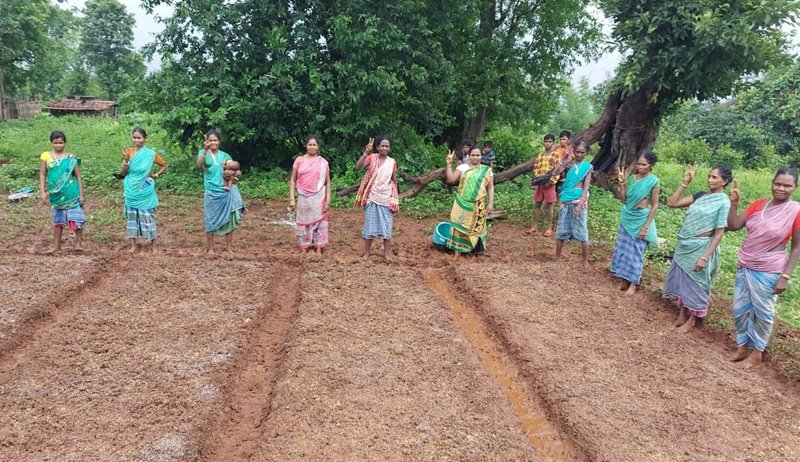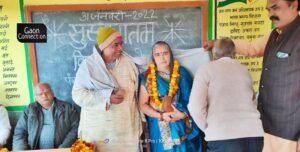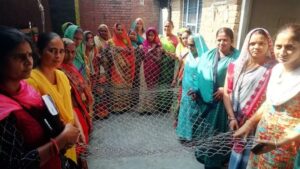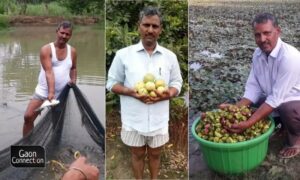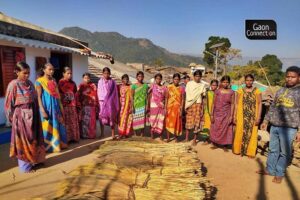At 8 am every morning, Sushma Samad, wearing her five-yard saree, hops on to her bicycle to cycle five kilometres from her village Kesra to her ‘office’ in Thethaitanagar block of Simdega district in Jharkhand.
On the way, she is joined by four of her village friends and together these women report for work at the village centre set up by the Jharkhand State Livelihood Promotion Society (JSLPS), a state government body that provides economic empowerment to rural women.
At the centre, Samad daily meet hundreds of women farmers, locally known as kisan didis, who come to sell forest produce such as kusum (Schleichera oleosa) and karanj (Millettia pinnata) painstakingly collected by them. She buys these produce at the market rate, packs them in huge sacks and sends it further to another centre of the JSLPS where these seeds are processed for oil extraction.
At least 120,000 women in Jharkhand are associated with JSLPS’s Mahila Kisan Sashaktikaran Pariyojana (MKSP), a scheme launched in 2011 that aims at improving the status of rural women in agriculture by providing them ample opportunities to earn livelihood. On average 10,000 women under the MKSP scheme are working in the Simdega district. For the project related to only Kusum and Karanj, 4,000 tribal women are working in the district.
This scheme is not limited to Simdega district alone. It is also being implemented in 10 blocks of some other districts in the state, including Hazaribagh.
Rural women as agri-entrepreneurs
At every stage of this scheme, rural women are the partners. Kisan didis collect the forest produce, such as mahua, kusum, karaj, imli (tamarind). This mix of produce is purchased by the self-help group members (all women) of JSLPS. Another set of women groups process these seeds for oil extraction and sale. Thus, a chain has been set up to empower rural women at every stage of the project.
“Kisan didis bring us vanopaj (forest produce). We buy those from them at the market price. This saves them the travel expenses to visit faraway markets. We collect the produce and send it to the JSLPS centre,” 42-year-old Samad, told Gaon Connection.
“This project also prevents women farmers from selling the forest produce at a loss to local mahajans (intermediaries),” she added.
By working for four to five hours at the centre, Samad and other rural women like her are able to earn a livelihood for themselves. “I am able to manage my household expenses now. Hath me paise ata hai na didi to acha lagta hai [It feels good to receive our earnings in our hand],” giggled Sushma, who has three kids and her husband is a farmer.
How does the project function?
There are three categories in which the Mahila Kisan Sashaktikaran Pariyojana functions in Simdega district — forest produce picking, collection, processing and oil extraction. At least 3,000 women farmers, 1,200 women collectors such as Samad, and 150 women processors are involved in the project in the district.
By June-end, forest produce such as karanj ripen and kisan didis harvest them from trees in bulk. The produce is collected from farmers at Rs 18 per kg thus providing an additional income of Rs 3,000 on average for one season crop. All of them receive money in commodity wise activities as seeds are collected crop wise.
“Earlier, farmers would get zero rupees for these seeds. Now, kisan didis earn up to Rs 3,000-4,000 in a season. The collectors, who would sell these to middlemen at throwaway prices, now earn up to Rs 6,000,” Arif Akhtar, state programme manager and state level value chain lead of JSLPS, told Gaon Connection. “Women associated with processing and packaging, and extraction earn up to Rs 4,000-5,000,” he added.
According to him, before this project was launched, local tribal people, who should be getting maximum benefits from the forest produce, were not getting any profits. “Industrialists and other groups were benefiting from it. Now tribal women have earned an identity as farmers. We are also imparting training for operating and repairing machines to women workers,” said Akhtar.
Also Read: Farmers in Jharkhand’s Khunti forgo opium cultivation, embrace lemongrass
Ensuring livelihood, health, sustainable agri practices
Through this project, members — all women– are ensuring sustainable agriculture practices as well.
“Earlier, women farmers in villages did not have means to harvest or sell non-timber seeds. These tribal groups are closely related to the environment but their method of harvesting would lead to deforestation as they would cut all branches,” Akhtar.
“Our first initiative was to develop a scientific harvesting system so that deforestation could be stopped and save these produce from extinction. When we gave training to farmers they understood there is an economic return for their produce. They started planting more trees,” he added.
There are health benefits of non-timber forest produce such as karanj and kusum. Akhtar informed that karanj oil is a very good substitute for neem oil. It is not edible but is used for medicinal purposes such as preventing skin diseases, allergy, and dandruff. It is pest repellent as well. Unlike karanj, kusum gives an edible oil.
“Kusum oil is also a good substitute for white oil (refined oil). If you track the procedure of white oil manufacturing, you will find how it is adulterated,” said the state programme manager of JSLPS. Other than that, cake left after oil extraction from the kusum seeds is used as an NPK [nitrogen-phosphorus-potassium] substitute to increase soil health and fertility.
Marketing and sales
At least 300 milliliters of oil gets extracted from one kg of kusum or karanj. The leftover, called cake, is sold for Rs 40 a kg. A litre of kusum and karanj oils is sold for Rs 165 and Rs 155, respectively. Last season, over 10 metric tonnes of both Karanj and Kusum oil were extracted under the project in Simdega district.
“This is a very lucrative business. We are working to support tribal groups. As of now, we sell oils through our FPOs [Farmer Producer Organisations], and Palash app. Soon, we will launch a sakhi-e-cart app where one can buy these oils,” informed the value chain lead.
“We have to strengthen the production unit to maximise the supply chain,” he added.
The change being brought about by this rural livelihoods scheme is visible. Samad now calls herself a business woman. “We rural women have learnt to do business. We used to do len den (business) of one hundred. Now we deal in thousands. We hope to soon do business in fifty thousand. This is just the beginning,” she smiled and said.

